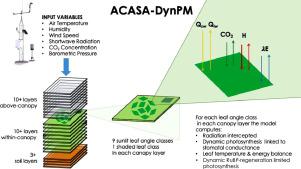Agricultural and Forest Meteorology ( IF 5.6 ) Pub Date : 2021-11-02 , DOI: 10.1016/j.agrformet.2021.108702 Nicolas E. Bambach 1 , Matthew E. Gilbert 2 , Kyaw Tha Paw U 1

|
More frequent, intense, and more extended droughts and heatwaves are challenging agricultural productivity and management. This study introduces a new modeling approach to represent the impact of heat and water stress on energy and mass fluxes from orchards. A photosynthesis model that explicitly accounts for dynamic responses of Rubisco and RuBP limitations to stress was linked to the Advanced Canopy-Atmosphere-Soil Algorithm (ACASA). ACASA is a multilayer soil-vegetation-atmosphere numerical model based on higher-order closure of turbulence equations to calculate plant-atmosphere exchanges of carbon dioxide, water, and heat. Field measurements of leaf area index, stomatal conductance, and photosynthesis were performed to estimate model parameters. Model results were compared to data from an eddy covariance flux tower deployed at an almond orchard. Overall, this new approach, ACASA-DynPM, is in closer agreement with observations of H, λE, and Fc compared to ACASA. On days of high temperatures and water stress, ACASA-DynPM outperforms ACASA. Thus, we argue that accounting for plant physiological stress might be especially relevant when estimating energy and mass fluxes over intensively irrigated agricultural regions. Such biases can have implications for the modeled degree of crop stress and water demands, and eventually, it can impact climate regional estimates when coupled with an atmospheric model.
中文翻译:

在下一代地表模型 ACASA 中引入光抑制、热和水分胁迫的动态光合模型
更频繁、更剧烈、更持久的干旱和热浪正在挑战农业生产力和管理。本研究引入了一种新的建模方法来表示热和水压力对果园能量和质量通量的影响。明确说明 Rubisco 和 RuBP 对压力限制的动态响应的光合作用模型与高级冠层-大气-土壤算法 (ACASA) 相关联。ACASA 是一种基于湍流方程的高阶闭合的多层土壤-植被-大气数值模型,用于计算二氧化碳、水和热量的植物-大气交换。进行叶面积指数、气孔导度和光合作用的现场测量以估计模型参数。模型结果与部署在杏仁果园的涡流协方差通量塔的数据进行了比较。总体而言,这种新方法 ACASA-DynPM 与观察到的结果更加一致。H、λE和F c与 ACASA 相比。在高温和缺水的日子里,ACASA-DynPM 的表现优于 ACASA。因此,我们认为,在估算集约灌溉农业区的能量和质量通量时,考虑植物生理压力可能尤其重要。这种偏差会对作物压力和需水量的模拟程度产生影响,最终,当与大气模型结合时,它会影响气候区域估计。









































 京公网安备 11010802027423号
京公网安备 11010802027423号